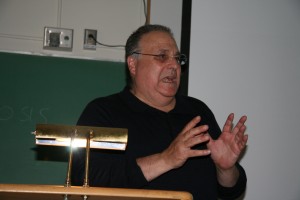Renny Pritikin Reminisces:
From Poet to Museum Curator
Can a man go from writing and performing poetry to curating contemporary art in world-class museums? If you ask Renny Pritikin, the answer is a resounding yes! Pritikin was the first in a series of featured speakers to appear in the Professions of Art: A Lecture Series, presented by the CSUS Art Department.
On September 8, 2011, Pritikin, who is the Director of the Nelson Gallery and Fine Arts Collection at UC Davis, spoke about his career, described numerous art shows he has curated, and gave his impressions of the art scene in Northern California. Professor Elaine O’Brien introduced Pritikin to the audience saying, “He’s a culture maker, one who shapes and defines the culture.” O’Brien added, “He brings a global awareness to his work and to the local art scene.”
Right from the start Pritikin admitted to the audience of students, faculty and members of the community, “I have never been asked to talk about myself before. It’s a great privilege.” He explained that in preparation for the talk he had to do a bit of detective work for himself. “I think about ‘why me?’ and why did I end up with a life in the arts?” Pritikin grew up in a middle class New York family explaining that neither of his parents went to college and that there was no art in his house. While he doesn’t really have an answer as to how he ended up living a life in the arts, Pritikin said, “I think about it all them time.”
Pritikin emphasized that he is not an art historian and that he came into the arts as a poet and later turned to being a curator and art writer. From 1975-1982 he served as the first director of New Langton Arts in San Francisco and in the 1990s was the Chief Curator of Visual Arts at San Francisco’s Yerba Buena Center for the Arts. Along the way he earned a Fulbright Fellowship and taught curatorial practices at the California College of the Arts in San Francisco.
A slide show of the art and artists he’s worked with accompanied Pritikin’s lecture. He has mounted shows for many contemporary artists some of whom Pritikin refers to as “fringe artists” and given many of them platforms for notoriety.
Among them is the magician Ricky Jay. Said Pritikin, “He’s the greatest slight of hand artist in the world, an actor, art historian of weird art who is interested in con-men and the underworld.” Pritikin described Jay’s collection of rotting dice as “beautiful metaphors for our bodies.” Jay’s enormous collection of freak-show posters were worthy of an exhibit put on by Pritikin who challenged the audience by asking the age-old question, “Is this art? Does this belong in a contemporary art museum?”
Pritikin has also given platforms to artist Don Ed Hardy (famous for his tattoo art and clothing line), Ed “Big Daddy” Roth, Tom Friedman, Kenji Yanobe, Leondro Erlich, Devorah Sperber, and Mark Pauline. Said Pritikin, “I get a guilty pleasure from trashy art.”
Of his time at Yerba Buena Pritikin said, “Our goal was to be the first art institution to deal with diversity. We were trying to open art to men of color and gays through thematic exhibits and a visual culture with stuff that was not intended to be art.” He said he was trying to show an aesthetic that included the working class and under class as worthy of museum shows. There was, however, no mention by Pritikin of women artists getting equal billing.
As for the Nelson, Pritikin explained, “My strategy and thinking at the Nelson is trying to build ties to the community.” To reach that goal he started the “Flatlanders” show, a bi-annual event so named because he felt the landscape here was flat and because he needed a catchy title. When asked how he selects artwork for the show, Pritikin answered, “It’s based completely on my own taste. I have a lot of confidence in my eye.”
Commenting on the local art scene Pritikin said, “I had to educated myself.” He admitted that when he arrived in Davis he was completely naïve and didn’t know who Fred Dalkey was. Now he finds the area to be, “an incredibly rich community with many talented artists.” However, he is both surprised and disappointed to find the area lacking in what he calls the two most important developments in the 21st century: digital art and social practice.
Pritikin closed out the evening on a positive note. When asked if he still does poetry Pritiken said not much. He concluded, “I used to say nothing in the art world is as interesting as finishing a poem. It’s like sex. But when you find an artist that is great and you organize a show and it’s great, everyone says (expletive), then that’s great!”



